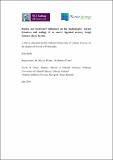| dc.contributor.advisor | White, Martin | |
| dc.contributor.author | Kelly, Seán | |
| dc.date.accessioned | 2020-01-10T08:14:39Z | |
| dc.date.available | 2020-01-10T08:14:39Z | |
| dc.date.issued | 2019-10-08 | |
| dc.identifier.uri | http://hdl.handle.net/10379/15686 | |
| dc.description.abstract | Estuarine and coastal water bodies are amongst the most productive and diverse habitats, providing crucial ecological and economic benefits. However, owing to their position at the interface between continents and the oceans, they are highly sensitive to natural and anthropogenic environmental change. Deoxygenation is increasingly recognised as a major threat to coastal ecosystems, with climate change heavily implicated in the expansion of oxygen depletion. Thus, there is a need to discern the physical processes that heighten susceptibility to severe deoxygenation. This project used Lough Furnace, a lagoonal estuary with deep anoxia, to address the following: what are the relative roles of marine, freshwater and
meteorological variables in controlling hydrography and dissolved oxygen dynamics? This was investigated using timeseries of hydrographic and meteorological observations. The anoxic inner basin revealed significant interannual oxygen variability over the past decade, with bottom water ventilations occurring every 2 years on average. Ventilations followed prolonged periods of low rainfall, allowing increasingly saline spring tides to traverse the long connecting channel and dense oxygen-rich water descend to the basin bottom. A simple model indicated that these oxygenations have become less frequent since 1979, due in large part to the higher rainfall in this region in the past 10-15 years. The implications of anoxia on resident fish ecology was assessed and it was revealed that wind-induced baroclinic seiches can cause deep anoxic water to
encroach into oxygenated nearshore zones. The marine-species dominated deep chlorophyll maximum was more conspicuous following low freshwater input and increased tidal inflows, sharing similar physical drivers with oxygen dynamics. Overall the study has indicated that oxygen dynamics result from a delicate interplay between freshwater, tidal and wind forces, which are all subject to modification under climate change, putting into uncertainty the future oxygen regimes in such systems. | en_IE |
| dc.publisher | NUI Galway | |
| dc.rights | Attribution-NonCommercial-NoDerivs 3.0 Ireland | |
| dc.rights.uri | https://creativecommons.org/licenses/by-nc-nd/3.0/ie/ | |
| dc.subject | Coastal oceanography | en_IE |
| dc.subject | Oxygen dynamics | en_IE |
| dc.subject | Estuarine ecology | en_IE |
| dc.subject | Hydrography | en_IE |
| dc.subject | Natural Sciences | en_IE |
| dc.subject | Earth and Ocean Science | en_IE |
| dc.title | Marine and freshwater influences on the hydrography, oxygen dynamics and ecology of an anoxic lagoonal estuary, Lough Furnace, Mayo, Ireland | en_IE |
| dc.type | Thesis | en |
| dc.contributor.funder | Cullen Fellowship, Marine Institute, Ireland | en_IE |
| dc.contributor.funder | Thomas Crawford Hayes Research Fund | en_IE |
| dc.contributor.funder | Global Lake Ecological Observatory Network Student Travel Award | en_IE |
| dc.local.note | This thesis quantified the role of freshwater, marine and meteorological influences on dissolved oxygen dynamics in an ecologically important coastal habitat, Lough Furnace. Oxygen levels depend on a specific combination of environmental conditions all influenced by climate. Implications for resident ecology in the face of changing oxygen were also assessed. | en_IE |
| dc.local.final | Yes | en_IE |
| nui.item.downloads | 134 | |


